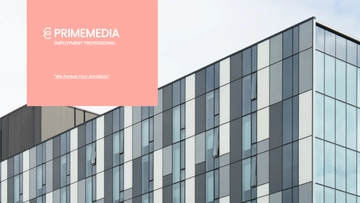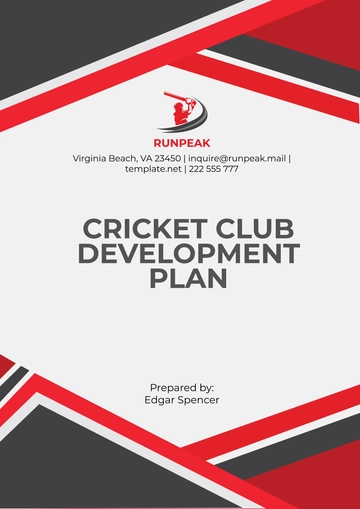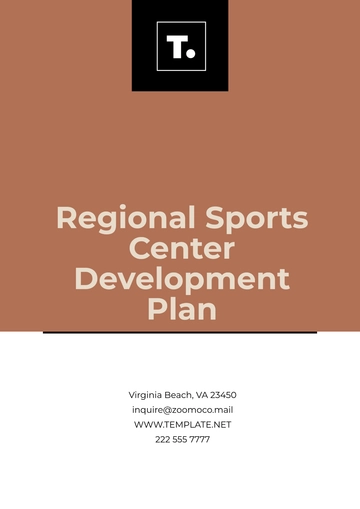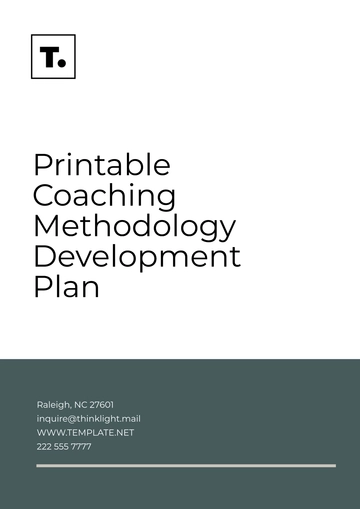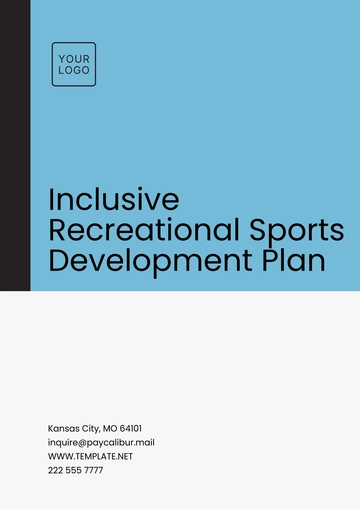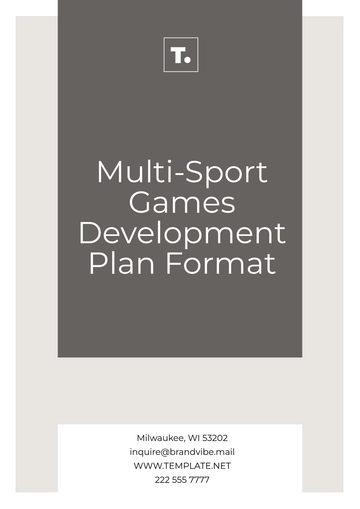Free Primary School Sports Development Plan Layout

Prepared by: [Your Name]
Date: June 14, 2050
1. Introduction
The Primary School Sports Development Plan is designed to create a comprehensive and engaging sports program that supports the physical, social, and emotional development of young students. The plan aims to encourage participation, develop physical skills, foster teamwork, and promote a lifelong commitment to health and fitness. By offering a variety of sports and physical activities, this plan seeks to engage every child, regardless of skill level, and provide them with opportunities to develop their potential in a fun and safe environment.
2. Objectives
The key objectives of the Primary School Sports Program are:
Encourage Active Lifestyles: Foster a love for physical activity and promote healthy lifestyle choices from an early age.
Develop Fundamental Movement Skills: Focus on developing essential physical skills, such as coordination, balance, and agility, to build a strong foundation for future participation in sports.
Promote Teamwork and Cooperation: Teach children how to work together, communicate, and support their peers through team-based activities and group challenges.
Provide Inclusive Opportunities: Ensure that all students, regardless of ability, have access to sports activities that suit their needs and abilities.
Support Social and Emotional Development: Use sports as a platform to teach life skills such as resilience, respect, and responsibility.
3. Needs Assessment
3.1 Current Program Evaluation
An assessment of the current sports program will be conducted based on the following factors:
Participation Rates: Monitor the number of students involved in sports activities across different grades.
Variety of Activities: Review the range of sports and activities offered to students.
Student Engagement: Gather feedback from students, teachers, and parents on the level of interest and enthusiasm for current sports programs.
Facilities and Resources: Evaluate the quality and accessibility of sports equipment and facilities.
3.2 Resources and Constraints
Identifying available resources and potential constraints is crucial for the development of the program:
Resources | Constraints |
|---|---|
Dedicated PE teachers and support staff | Limited budget for sports equipment |
Existing outdoor play areas and gyms | Limited time for physical education due to academic schedules |
Community partnerships with local clubs | Limited staff training in certain sports |
Parent and community engagement | Space limitations for some activities |
4. Program Development
4.1 Expanding and Enhancing Sports Offerings
To cater to diverse interests and abilities, the program will include a variety of activities:
Introduce New Sports: Introduce age-appropriate sports such as soccer, netball, swimming, gymnastics, and athletics to offer a wide range of options for students.
Physical Activity Challenges: Organize fun physical activity challenges, such as relay races, obstacle courses, and fitness circuits, to encourage engagement and friendly competition.
Inter-Class Competitions: Establish friendly competitions between classes to build school spirit and foster teamwork.
Incorporate Non-Competitive Activities: Include non-competitive activities, such as dance, yoga, and fitness games, to allow students to enjoy physical activity without the pressure of competition.
4.2 Staff Development and Training
To ensure the success of the program, the staff will receive ongoing training:
Professional Development for PE Teachers: Provide regular training opportunities to enhance teachers’ knowledge of child development, coaching methods, and safety standards in physical education.
Guest Coaches and Specialists: Invite experts or guest coaches to conduct workshops, introducing new sports and techniques to both staff and students.
4.3 Facility and Equipment Enhancements
To create an optimal environment for sports activities, the following steps will be taken:
Upgrade Existing Facilities: Ensure that playgrounds, sports halls, and outdoor fields are safe, well-maintained, and suitable for all activities.
Purchase Age-Appropriate Equipment: Invest in quality, age-appropriate sports equipment such as balls, cones, mats, and jump ropes to support a range of sports and physical activities.
Storage and Accessibility: Improve the storage and accessibility of equipment to ensure it is available and ready for use during activities.
5. Implementation Plan
5.1 Short-Term Goals (6-12 months)
Increase participation rates by introducing engaging, age-appropriate sports activities.
Implement an intramural program with inter-class competitions to encourage friendly rivalry and teamwork.
Purchase new equipment and upgrade facilities to meet the needs of students.
Establish regular PE classes to ensure every student receives consistent opportunities for physical activity.
5.2 Long-Term Goals (1-3 years)
Develop and host an annual sports day that involves students, teachers, and families, celebrating physical activity and achievement.
Establish community partnerships with local sports clubs to provide students with pathways for continued physical development.
Create a school sports team to represent the school in local competitions.
Ensure that 100% of students engage in physical activity at least three times a week.
6. Evaluation and Monitoring
6.1 Performance Indicators
The effectiveness of the program will be monitored using the following indicators:
Participation Rates: Track the number of students involved in sports and physical activities.
Student Feedback: Conduct surveys and interviews with students to assess their interest and satisfaction with the sports program.
Parent and Teacher Feedback: Collect input from parents and teachers regarding the program’s impact on students’ physical and social development.
Health and Fitness Improvements: Measure the overall improvement in students' physical health, such as fitness levels, coordination, and stamina.
6.2 Review Process
The program will undergo an annual review process:
Review Meetings: Hold meetings with school leadership, PE staff, and other stakeholders to evaluate the program’s success and challenges.
Student and Parent Surveys: Collect feedback from students and parents to ensure that the program meets the needs of the community.
Adjustments and Enhancements: Use the review results to make necessary changes, such as adding new activities, purchasing additional equipment, or adjusting the program’s schedule.
7. Risk Management and Safety
It is essential to ensure student safety during all sports activities. Key strategies include:
Injury Prevention: Implement safe practices for each sport, including warm-ups, cool-downs, and injury prevention protocols.
Qualified Staff: Ensure all physical education teachers are trained in first aid and emergency procedures.
Supervision: Ensure adequate adult supervision during all activities, both indoors and outdoors, to prevent accidents.
8. Conclusion
The Primary School Sports Development Plan is focused on creating a well-rounded, inclusive, and enjoyable sports program that engages students, supports their physical and social development, and promotes a lifetime of physical activity. By enhancing sports offerings, providing ongoing staff development, improving facilities and equipment, and ensuring continuous evaluation, the plan aims to provide every child with the opportunity to grow, develop, and thrive through sports and physical activity.
- 100% Customizable, free editor
- Access 1 Million+ Templates, photo’s & graphics
- Download or share as a template
- Click and replace photos, graphics, text, backgrounds
- Resize, crop, AI write & more
- Access advanced editor
The Primary School Sports Development Plan Layout Template from Template.net is a fully editable and customizable solution to streamline your sports planning. With easy-to-use features, you can tailor every detail to meet your school's needs. Editable in our Ai Editor Tool, this template ensures a smooth and efficient process for sports development planning.

